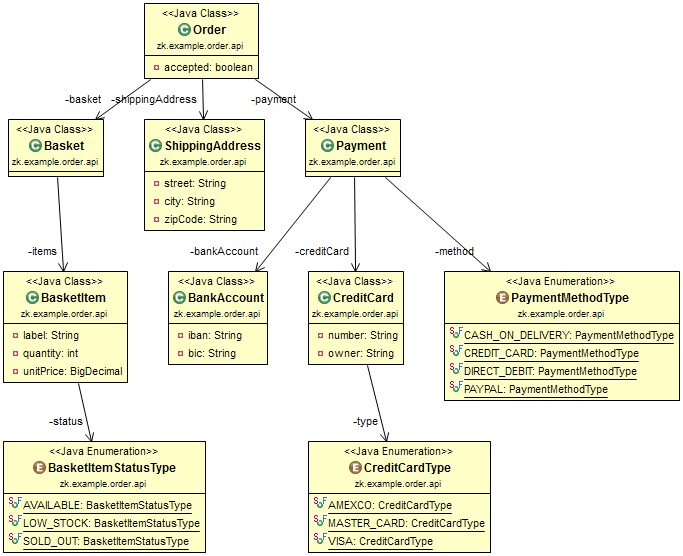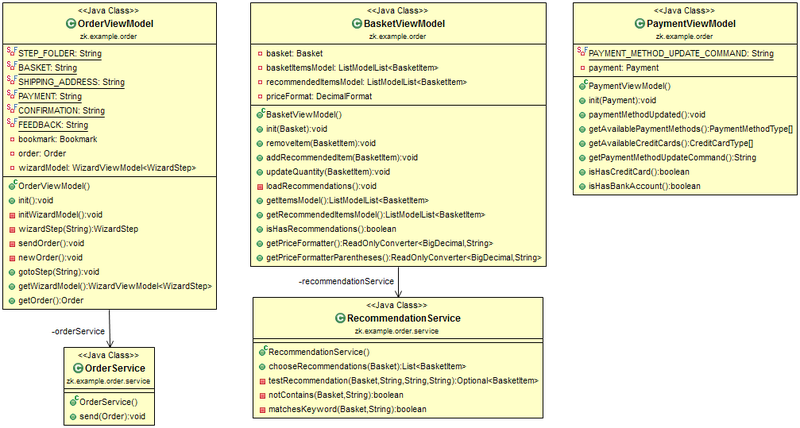ZK8 Wizard Example - Part 2
Robert Wenzel, Engineer, Potix Corporation
July/August 2015
ZK 8.0
Introduction
In the previous Part 1 LINK ME I created a wizard template together with a model. I showed its usage in a trivial case. This Part will focus on reusing the same wizard template in a different scenario with more complex steps. I'll go deeper into templating and reuse various parts of the UI.
I'll also highlight some optional features to give the example more of a real life feeling.
Order Wizard (a more complex example)
As an example I chose a typical shopping basket and checkout process with the following steps:
- Basket
- review/adjust basket (add/remove/change items)
- display recommendations based on the basket content
- Shipping Address
- enter shipping address
- Payment
- choose payment method + enter conditional details
- Confirmation
- review data, accept GTC submit order (handle exceptions)
- Feedback
- user feedback when order was successful
Here a preview of the order wizard:
Order Model
The order model consists of straight forward java bean classes, to hold the data input during the order process. These classes are unaware of being used in inside a Wizard they simply provide getters and setters to hold/represent their state. (When looking into the code don't be confused by the validation annotations I'll talk about this topic in Part 3 LINK ME.)
Wizard/Step View Models
There are 3 view model classes representing our Ordering process. The OrderViewModel controls the overall wizard, initializes the steps and eventually submits the final order. Two of the wizard steps require additional logic which is implemented in BasketViewModel(adding/removing basket items and display recommendations) and PaymentViewModel (handle payment method changes).
Creating the UI
The order.zul [1] doesn't contain anything new.
<?component name="wizard" templateURI="/WEB-INF/zul/template/wizard/wizard.zul" ?>
<zk>
<div width="500px"
viewModel="@id('vm') @init('zk.example.order.OrderViewModel')"
validationMessages="@id('vmsgs')"
onBookmarkChange="@command('gotoStep', stepId=event.bookmark)">
<wizard wizardModel="@init(vm.wizardModel)" order="@init(vm.order)"/>
</div>
</zk>
More interesting are the individual step pages.
steps 2-4 shipping/payment/confirmation [2]
I'll start with the simpler steps for inputting the order information, as they share a common row based layout: one row for each input field.
- /src/main/webapp/WEB-INF/zul/order/steps/shippingAddress.zul [3]
- plain input form no addtional viewmodel required
<?taglib uri="/WEB-INF/tld/i18n.tld" prefix="i18n"?>
<?component name="formRow" templateURI="/WEB-INF/zul/template/wizard/formRow.zul" ?>
<zk xmlns:sh="shadow">
<grid>
<rows>
<formRow type="static" label="@init(i18n:nls('order.basket'))" value="@init(order.basket)"/>
</rows>
</grid>
${i18n:nls('order.shippingAddress.hint')}
<grid>
<rows>
<formRow type="textbox" label="@init(i18n:nls('order.shippingAddress.street'))"
value="@ref(order.shippingAddress.street)"/>
<formRow type="textbox" label="@init(i18n:nls('order.shippingAddress.city'))"
value="@ref(order.shippingAddress.city)"/>
<formRow type="textbox" label="@init(i18n:nls('order.shippingAddress.zipCode'))"
value="@ref(order.shippingAddress.zipCode)"/>
</rows>
</grid>
</zk>
- Line 6: Note: the static value is passed using @init
- Lines 13, 15, 17: Note: the editable values use reference binding - @ref(...) [4] - not a new but often overlooked feature
- /src/main/webapp/WEB-INF/zul/order/steps/payment.zul [5]
- the payment page uses the PaymentViewModel [6] to control the visibility of conditional input fields for credit card and direct debit
<?taglib uri="/WEB-INF/tld/i18n.tld" prefix="i18n"?>
<?component name="formRow" templateURI="/WEB-INF/zul/template/wizard/formRow.zul" ?>
<zk xmlns:sh="shadow" xmlns:ca="client/attribute">
<grid>
<rows>
<formRow type="static" label="@init(i18n:nls('order.basket'))" value="@init(order.basket)"/>
<formRow type="static" label="@init(i18n:nls('order.shippingAddress'))" value="@init(order.shippingAddress)"/>
</rows>
</grid>
${i18n:nls('order.payment.hint')}
<grid viewModel="@id('paymentVM') @init('zk.example.order.PaymentViewModel', payment=order.payment)"
payment="@ref(order.payment)">
<rows>
<formRow type="selectbox" label="@init(i18n:nls('order.payment.method'))" value="@ref(payment.method)"
model="@init(paymentVM.availablePaymentMethods)"
updateCommand="@init(paymentVM.paymentMethodUpdateCommand)"/>
<sh:if test="@load(paymentVM.hasCreditCard)">
<formRow type="selectbox" label="@init(i18n:nls('order.payment.creditCard.type'))"
value="@ref(payment.creditCard.type)"
model="@init(paymentVM.availableCreditCards)" />
<formRow type="creditcard" label="@init(i18n:nls('order.payment.creditCard.number'))"
value="@ref(payment.creditCard.number)" />
<formRow type="textbox" label="@init(i18n:nls('order.payment.creditCard.owner'))"
value="@ref(payment.creditCard.owner)" />
</sh:if>
<sh:if test="@load(paymentVM.hasBankAccount)">
<formRow type="textbox" label="@init(i18n:nls('order.payment.bankAccount.iban'))"
value="@ref(payment.bankAccount.iban)" />
<formRow type="textbox" label="@init(i18n:nls('order.payment.bankAccount.bic'))"
value="@ref(payment.bankAccount.bic)" />
</sh:if>
</rows>
</grid>
<template name="creditcard">
<textbox value="@bind(value)" ca:data-mask="${i18n:nls('order.creditCard.number.format')}"/>
</template>
</zk>
- Lines 18, 28: conditional inputs
- Line 15: using model to render the selectbox
- Line 16: passing in a viewmodel command via updateCommand to be notified of value changes
- Lines 22, 37: injecting a custom template/type, to render a special input using an input mask
Every row is rendered using the same formRow template.
Form Row template
The core of this example is the formRow template which renders a form field based on the parameters type, label, value (and some optional parameters). Internally it uses several shadow components to achieve dynamic row rendering. It tries to reuse as much layout per row as possible (we'll enhance this template with validation messages in PART 3 LINK ME). The templates for input elements require additional parameters such as model (used for selectbox) and updateCommand for @command binding.
- /src/main/webapp/WEB-INF/zul/order/steps/payment.zul [7]
<zk xmlns:sh="shadow">
<row>
<sh:choose>
<sh:when test="@init(type eq 'checkbox')">
<cell/>
</sh:when>
<sh:otherwise>
<label value="@init(label)"/>
</sh:otherwise>
</sh:choose>
<sh:apply template="@init(type)"/>
</row>
<template name="checkbox">
<checkbox checked="@bind(value)" onCheck="@command(updateCommand)" label="@load(label)"/>
</template>
<template name="textbox">
<textbox value="@bind(value)" onChange="@command(changeCommand)"/>
</template>
<template name="selectbox">
<selectbox selectedItem="@bind(value)" model="@load(model)" onSelect="@command(updateCommand)">
<template name="model">
<label value="@init(i18n:nls(each))"/>
</template>
</selectbox>
</template>
<template name="static">
<label value="@load(value)" />
</template>
<template name="static-bookmark-link">
<a label="@load(value)" href="@init(('#' += bookmark))"/>
</template>
</zk>
- Lines 15, 19, 23: binds the value passed in via @ref from the outside
step 1 basket.zul
- /src/main/webapp/WEB-INF/zul/order/steps/basket.zul [8]
- The first wizard step renders the basket items in a grid - nothing special about it, hence the abbreviated source.
<?taglib uri="/WEB-INF/tld/i18n.tld" prefix="i18n"?>
<zk xmlns:sh="shadow" xmlns:x="xhtml" >
<div viewModel="@id('basketVM') @init('zk.example.order.BasketViewModel', basket=order.basket)">
...
${i18n:nls('order.basket.hint')}
<grid model="@init(basketVM.itemsModel)">
...
<div>
<sh:apply template="basketItemLabel" item="@init(item)"/>
<a iconSclass="z-icon-times" sclass="red" onClick="@command('removeItem', basketItem=item)" tooltiptext="remove"/>
</div>
...
</grid>
<sh:if test="@load(basketVM.hasRecommendations)">
<vlayout>
${i18n:nls('order.basket.recommendation')}
<sh:forEach items="@init(basketVM.recommendedItemsModel)">
<div sclass="recommendation" onClick="@command('addRecommendedItem', item=each)" tooltiptext="add to basket">
<sh:apply template="basketItemLabel" item="@init(each)"/>
<a iconSclass="z-icon-plus green" href="#" />
</div>
</sh:forEach>
</vlayout>
</sh:if>
<template name="basketItemLabel">
<label value="@load(item.label)"/>
<label value="@load(item.unitPrice) @converter(basketVM.priceFormatterParentheses)"/>
</template>
</div>
</zk>
- Lines 9, 20, 27: a simple way to use a basketItemLabel-template in 2 places
- Line 18: using
<sh:forEach>bound to a ListModelList
At the bottom some of the new shadow elements (if, foreach, apply) are used to dynamically display the recommendations based on the current basket contents. Especially powerful is the combination of forEach and ListModelList. It will automatically expand/shrink/rearrange the items whenever the ListModelList (recommendedItemsModel) is changed.
Here a sample of what is required for this in the BasketViewModel [9]:
public class BasketViewModel {
//in the real life application injected using @WireVariable
private RecommendationService recommendationService = new RecommendationService();
private Basket basket;
private ListModelList<BasketItem> basketItemsModel;
private ListModelList<BasketItem> recommendedItemsModel;
...
@Command("addRecommendedItem")
public void addRecommendedItem(@BindingParam("item") BasketItem item) {
basketItemsModel.add(item);
BindUtils.postNotifyChange(null, null, basket, "totalPrice");
loadRecommendations();
}
...
private void loadRecommendations() {
recommendedItemsModel.clear();
recommendedItemsModel.addAll(recommendationService.chooseRecommendations(this.basket));
BindUtils.postNotifyChange(null, null, this, "hasRecommendations");
}
...
- Line 8: the view model holds a ListModelList to contain the basket recommendations
- Line 16: whenever the basket is updated (e.g. an item is added) reload the recommendations
- Line 23: by changing the contents of the ListModelList the bound <forEach> element does it's job automatically
It is not necessary to clear and replace all items - forEach can also handle single item additions/removals/movements, and will only reflect those changes in the component tree to reduce the overhead. This example simply illustrates, that it happens automatically, no additional notifyChange on the recommendedItemsModel is required to reflect the updated recommendations in the page.
Additional features
As in a real application there are always requirements that somehow "distract" from the core solution. I just picked a few to show they don't necessarily break the overall design.
Input Mask
The payment.zul page uses an input mask to format the credit card number during user input. These kind of client side 'effects' can now be applied easily with custom data-handlers (ZK 8).
<template name="creditcard">
<textbox value="@bind(value)" ca:data-mask="${i18n:nls('order.creditCard.number.format')}"/>
</template>
In the zk.xml the handler is configured as follows, it is loading an external jquery plugin (on demand, can be any JS resource), and decorates the widget with the JS code during initialization on the client side. The server side component behaves as usual receiving the unmasked value while the view model isn't even aware of that.
<data-handler>
<name>mask</name><!-- the attribute name, i.e. data-mask -->
<depends>http://igorescobar.github.io/jQuery-Mask-Plugin/js/jquery.mask.min.js</depends>
<script>
function (wgt, dataValue) {
jq(wgt.$n()).mask(dataValue);
wgt.listen({
onChange: function (event) {
event.data.value = jq(this.$n()).cleanVal();
}
});
}
</script>
</data-handler>
Bookmark Handling
A simple bookmarking mechanism is added to enable browser back navigation without leaving the wizard, nothing new but often forgotten while very simple to implement.
- /wizardexample/src/main/webapp/order.zul
- when a bookmark change is detected send the 'gotoPage' command
<?component name="wizard" templateURI="/WEB-INF/zul/template/wizard/wizard.zul" ?>
<zk>
<div width="500px"
viewModel="@id('vm') @init('zk.example.order.OrderViewModel')"
validationMessages="@id('vmsgs')"
onBookmarkChange="@command('gotoStep', stepId=event.bookmark)">
<wizard wizardModel="@init(vm.wizardModel)" order="@init(vm.order)"/>
</div>
</zk>
- zk.example.order.OrderViewModel
- whenever the wizard step changes set a bookmark, and vice versa, goto a step when the bookmark changes
wizardModel = new WizardViewModel<WizardStep>(availableSteps) {
@Override
protected void onStepChanged(WizardStep currentStep) {
bookmark.set(currentStep.getId(), false);
}
};
...
@Command("gotoStep")
public void gotoStep(@BindingParam("stepId") String stepId) {
if(!getWizardModel().gotoStep(stepId)) {
//if step change unsuccessful override the bookmark
bookmark.set(wizardModel.getCurrentStep().getId(), true);
};
}
- zk.example.wizard.Bookmark
- for completeness the trivial Bookmark class
public class Bookmark {
public void set(String currentStepId, boolean replaceBookmark) {
Executions.getCurrent().getDesktop().setBookmark(currentStepId, replaceBookmark);
}
}
Custom I18N
To enable I18N the labels have been defined in the zk-label.properties and a custom mechanism is put place to conveniently convert enumerations to labels, icons or styles, in the same way as resolving plain simple labels.
- /wizardexample/src/main/webapp/WEB-INF/zk-label.properties
- defines the labels, enables adding localized versions e.g. zk-label_de.properties
- zk.example.i18n.NlsFunctions
- a set of I18n functions used throughout the application, both in zul and java code
Used via custom taglib functions in a zul file:
<?taglib uri="/WEB-INF/tld/i18n.tld" prefix="i18n"?>
...
${i18n:nls('order.shippingAddress.hint')}
...
<formRow type="static" label="@init(i18n:nls('order.basket'))" value="@init(order.basket)"/>
...
Called directly in java code:
DecimalFormat decimalFormat = new DecimalFormat(NlsFunctions.nls("order.price.format"));
return NlsFunctions.nlsArgs("order.basket.format", getTotalItems(), decimalFormat.format(getTotalPrice()));
Summary
Next -> Validation LINK ME'
Download
- The source code for this article can be found in github (tag: part-2).
Running the Example
Checkout the tag part-2
git checkout part-2
The example war file can be built with maven:
mvn clean package
Execute using jetty:
mvn jetty:run
Then access the overview page http://localhost:8080/wizardexample/order.zul
Comments
| Copyright © Potix Corporation. This article is licensed under GNU Free Documentation License. |

